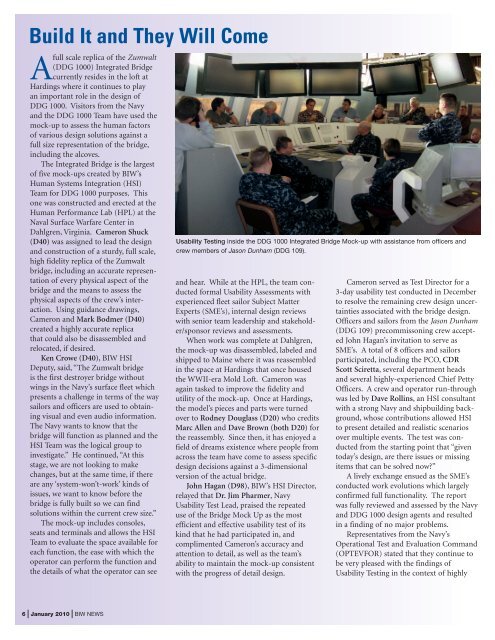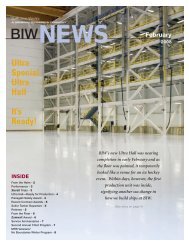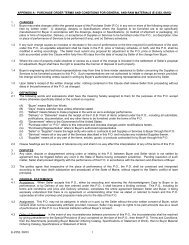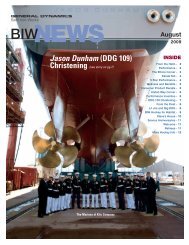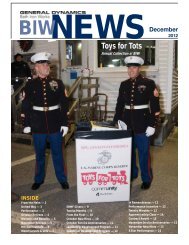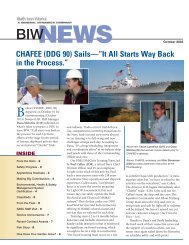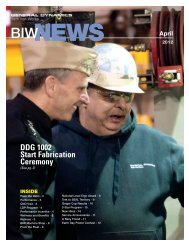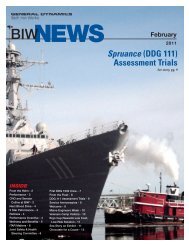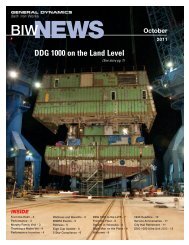JAN - Bath Iron Works
JAN - Bath Iron Works
JAN - Bath Iron Works
Create successful ePaper yourself
Turn your PDF publications into a flip-book with our unique Google optimized e-Paper software.
Build It and They Will ComeAfull scale replica of the Zumwalt(DDG 1000) Integrated Bridgecurrently resides in the loft atHardings where it continues to playan important role in the design ofDDG 1000. Visitors from the Navyand the DDG 1000 Team have used themock-up to assess the human factorsof various design solutions against afull size representation of the bridge,including the alcoves.The Integrated Bridge is the largestof five mock-ups created by BIW’sHuman Systems Integration (HSI)Team for DDG 1000 purposes. Thisone was constructed and erected at theHuman Performance Lab (HPL) at theNaval Surface Warfare Center inDahlgren, Virginia. Cameron Shuck(D40) was assigned to lead the designand construction of a sturdy, full scale,high fidelity replica of the Zumwaltbridge, including an accurate representationof every physical aspect of thebridge and the means to assess thephysical aspects of the crew’s interaction.Using guidance drawings,Cameron and Mark Bodmer (D40)created a highly accurate replicathat could also be disassembled andrelocated, if desired.Ken Crowe (D40), BIW HSIDeputy, said, “The Zumwalt bridgeis the first destroyer bridge withoutwings in the Navy’s surface fleet whichpresents a challenge in terms of the waysailors and officers are used to obtainingvisual and even audio information.The Navy wants to know that thebridge will function as planned and theHSI Team was the logical group toinvestigate.” He continued, “At thisstage, we are not looking to makechanges, but at the same time, if thereare any ‘system-won’t-work’ kinds ofissues, we want to know before thebridge is fully built so we can findsolutions within the current crew size.”The mock-up includes consoles,seats and terminals and allows the HSITeam to evaluate the space available foreach function, the ease with which theoperator can perform the function andthe details of what the operator can seeUsability Testing inside the DDG 1000 Integrated Bridge Mock-up with assistance from officers andcrew members of Jason Dunham (DDG 109).and hear. While at the HPL, the team conductedformal Usability Assessments withexperienced fleet sailor Subject MatterExperts (SME’s), internal design reviewswith senior team leadership and stakeholder/sponsorreviews and assessments.When work was complete at Dahlgren,the mock-up was disassembled, labeled andshipped to Maine where it was reassembledin the space at Hardings that once housedthe WWII-era Mold Loft. Cameron wasagain tasked to improve the fidelity andutility of the mock-up. Once at Hardings,the model’s pieces and parts were turnedover to Rodney Douglass (D20) who creditsMarc Allen and Dave Brown (both D20) forthe reassembly. Since then, it has enjoyed afield of dreams existence where people fromacross the team have come to assess specificdesign decisions against a 3-dimensionalversion of the actual bridge.John Hagan (D98), BIW’s HSI Director,relayed that Dr. Jim Pharmer,NavyUsability Test Lead, praised the repeateduse of the Bridge Mock Up as the mostefficient and effective usability test of itskind that he had participated in, andcomplimented Cameron’s accuracy andattention to detail, as well as the team’sability to maintain the mock-up consistentwith the progress of detail design.Cameron served as Test Director for a3-day usability test conducted in Decemberto resolve the remaining crew design uncertaintiesassociated with the bridge design.Officers and sailors from the Jason Dunham(DDG 109) precommissoning crew acceptedJohn Hagan’s invitation to serve asSME’s. A total of 8 officers and sailorsparticipated, including the PCO, CDRScott Sciretta, several department headsand several highly-experienced Chief PettyOfficers. A crew and operator run-throughwas led by Dave Rollins, an HSI consultantwith a strong Navy and shipbuilding background,whose contributions allowed HSIto present detailed and realistic scenariosover multiple events. The test was conductedfrom the starting point that “giventoday’s design, are there issues or missingitems that can be solved now?”A lively exchange ensued as the SME’sconducted work evolutions which largelyconfirmed full functionality. The reportwas fully reviewed and assessed by the Navyand DDG 1000 design agents and resultedin a finding of no major problems.Representatives from the Navy’sOperational Test and Evaluation Command(OPTEVFOR) stated that they continue tobe very pleased with the findings ofUsability Testing in the context of highly6 | January 2010 | BIW NEWS


